
ROOM: „...we are advocates of virgin purity.“
There are not many options to immediately engage in real life after finishing architecture studies. The safest option seems to be an internship in an established architectural studio. However, it's not uncommon to escape to another field. More and more frequently, we can encounter the option that is undoubtedly the riskiest but probably also the most exciting. The emergence of a young architectural group has become an interesting phenomenon. According to theorist Jan Tabor, young teams in Austria arise from various reasons: practical "sharing" of rental costs, different experiences, and skills. Their group "spirit" maintains playfulness and supports collaboration with other artists and designers. It stimulates interest in new areas of creativity beyond the traditional sphere of architecture. They want to stand out and attract attention. They increase their popularity by organizing joint exhibitions and, last but not least, with catchy names (the next ENTERprise, pool, transparadiso...). Recently, several architectural studios have also emerged in Slovakia, often with an average age not exceeding 30 years. One of the most prominent and youngest of these groups is the architectural studio RAUM: Marcel Dzurila, Peter Jurkovič, Lukáš Kordík, Roman Žitňanský. We spoke with Lukáš and Roman about what it's like.
-Why RAUM?
Lukáš Kordík: We were originally called Unit. After we moved, we discovered an advertisement for a "provider" with that name in the neighborhood. We came up with RAUM on the train from Košice while working on the Aupark competition. We thought this could be the official start with a new name. RAUM (it also contained TRAUM) may reference raumplan, space in general, but there's no need to seek any serious philosophy behind it. (The name came first, and then we added the philosophy...). So it would be easy "to pronounce." From the start, we didn’t want abbreviations of names.
-The industrial space you occupy is shared with the similarly young and ambitious studio Vallo & Sadovsky architects (VSA). Do you influence each other, help each other out? And what about rivalry and competition for clients?
Roman Žitňanský: There is certainly no competition. We are friends. Everyone plays in their own sandbox, we don’t throw sticks under each other's feet. When help is needed, we are happy to assist.
L.K.: Well, it's not that harmonious either. We definitely exchange experiences and advise each other. But we can also tease each other quite decently. But there are certainly no joint brainstorming sessions.
-It is indeed a beautiful space, and it's actually in the city center. What is the rent like here?
R.Ž.: We share the rent based on how much space each of us uses; we pay about 15 thousand for our part. The owners change frequently; in the year and a half we've been here, it’s already been the fourth owner, and it certainly isn’t permanent. The space is representative, but we share it with 3 teams, and sometimes it can be quite a problem to hold a meeting within our own team. But it can't compare to how we were squeezed into 30m² with three people in our previous space. That was complete "hardcore." Then we wanted to rent an apartment, which was also impossible, since we wanted it officially so it could be deducted as an expense. Then this space became available.
-Austrian Alles Wird Gut describes its condition: average age: 32.8, office area: 170m², window area: 38m², company car: Alfa Romeo 147 JTD, PC - performance: 16.1 GHz, coffee machine: Isomac. How do you compare?
L.K.: If we were doing better, we wouldn’t have to work at all (laughs).
R.Ž.: We survive, but we don’t save anything. It’s hard to calculate precisely because sometimes there are dry spells when we scrape by and then it piles up again. We are constantly working on various projects, and many of them are still unpaid.
L.K.: The best would be if there were little work, good work, and well-paid work. So there would be time for it. We are still at the beginning and trying to put in the maximum. We are often running around and solving things. And that work is never paid. It translates into phone calls, into traveled kilometers, etc.
-You were classmates at FA STU. Did the idea of a joint studio come about in school? Under what circumstances did you decide to go "for it" together?
L.K.: No, it was a coincidence. I was initially only with Peťo. Later I started working with Oliver (VSA). Then Matúš (VSA) got involved, and then we split up. We kept adding someone else. The basis was to get together. I couldn't imagine a Slovak studio where I would want to work. Roman and I were together in France through the "Erasmus" program (where we basically did nothing). We've been together in this final lineup for three years. We got together right after school when we had to start paying social security, etc. Some of us already knew each other from high school. Everything in Bratislava is just interconnected.
However, certain changes have occurred. We are no longer four, but three. Marcel left for various reasons at the beginning of the year. I think he will end up as a member of parliament or mayor. Marcel left right after he succeeded in the local elections. He is now working for a construction company. He has a fresh family and needed bigger security. It's true that it has been quite stressful here lately.
-It is said that when a company survives three critical years, only then can one consider it a functioning company. Is this true in the architectural business? What have you learned in your three years of existence?
L.K.: We are like communists. After three years, we figured out what works and what doesn’t; everyone profiles themselves. Marcel left. Maybe someone else will replace him and push it somewhere else. We’ll see...
-Each of you has at least minimal experience in another studio (Fabrica, IKEA, Skoček, KFA, Fr). Did you bring various procedures from those studios and apply them in forming yours? They say that working somewhere is a fast track. You go through the "u.r.-ko," etc.
L.K.: We are advocates of "virgin purity."
R.Ž.: I worked for Ilja Skoček. He was a machine in this regard; he had his systems. But that can’t be fully adopted. Maybe at first we had some similar system, but we’ve moved on. And mainly, Ilja is an interior designer, so I did very little design work with him. Today, we assign those tasks to professionals. Personally, I admit that I still don’t know a lot about it.
-And who among you knows something about it?
L.K.: Marcel was that! He’s a machine. When he sat down to it, Cad just burned. Today I drew the drawing of plugs for the first time, and I don’t know how to finish it. We know who is best at what, and we try to divide it up.
R.Ž.: Marcel always did the "dirty work." Even with those offices, he had his women, of whom we had no idea. He communicated all that. Now at least we will be forced to tackle it ourselves.
-You are here dressed rather "freestyle." Do you go to meetings in suits? Or at least in black?
L.K.: We don’t deal with it; we dress however everyone likes. Recently, I’m so irritated that jeans restrict me too much.
R.Ž.: But many times they think of us as some kind of jerks.
L.K.: We’ve never worn suits.
R.Ž.: When we went to present in Košice, we were indeed better dressed, but not in suits.
-Young (not only) architects sometimes feel a sense of superiority from investors, professionals, or builders due to their age and inexperience. Do you think that the way of presenting also contributes to that?
R.Ž.: We have reached a stage where when someone wants something from us, it's due to work, not because of how we look. Rather, on the construction site, when masters see us, they tend to show that they know better than us.
L.K.: In Slovakia, everyone is an architect. Everyone has remodeled a cottage or worked on a flat and knows better how to do it...
-So do you recommend young, starting architects to gain experience in an established architectural firm, or are you advocates of "virgin purity"?
L.K.: Certainly, such an experience is positive, but it depends on which studio...
R.Ž.: But school can also ruin you.
-Are you making a living from your work? According to "Wonderland," most projects by young starting studios consist of family orders. Is that the case with you?
L.K.: The worst is doing work for family. For friends, even worse.
R.Ž.: There was a change with the Peugeot competition in Trnava with Števo Polakovič. Until then, we were basically doing everything. Števo then contacted us through Matúš Vallo for a competition on apartment buildings, which we won, but of course nothing came of it. Since then, we’ve started collaborating more intensively with Števo. When we had no work, we did some projects with him.
L.K.: Regarding those private matters: there's one line from Peťo. Those are the top managers of Slovak IT companies. They all want houses now. Interiors are for friends. During the SUSHI project, I met a classmate from high school who started telling me about SUSHI and cassette ceilings. We didn't give it large chances, and in the end, it was successfully realized. Someone always gets a break. We've only done a few competitions. The competition for Aupark led to a distaste for competing. We did a competition in the Czech Republic for a primary school in Úvaly. For Oracle, we arranged office spaces. From that, the "Vlna" design emerged, which was selected for a world design exhibition.
A house was made for Peťo's uncle, who then recommended us to someone else. VSA cannot understand how many houses we are currently working on (laughs). They are leading family houses, apartments, and moderately-sized apartment buildings. Recently, they’ve also ventured into urbanism.
-That is quite a big leap from "Vlna" to urbanism. So tell us something about that urbanism.
L.K.: It’s a larger topic, urbanism around Bratislava on 50 hectares. It arose from the investor's initiative who contacted us but had an interesting condition: he wanted to involve a foreign studio. Together with the investor, we traveled to the Netherlands, first to a studio where we didn't succeed. Then we reached out to John Bosch. We already knew John through the guys from VSA who had already collaborated with him on a project in Bratislava. He got into it quite well, initially somewhat awkwardly, but then we clicked on a human level, and I think the investor is ultimately satisfied too. Hopefully, the result will be as well. We just signed the contract. So we travel to the Netherlands about three times a month, and John comes here as often.
-The biggest problem for young architects is clients' distrust due to age and inexperience. It is well known that the combination of a starting studio with an experienced, authorized architect is a proven and often used way to realize their visions even without missing experience and references. How have you dealt with this issue?
L.K.: We’ve been working on some projects with Števo Polakovič and Roman Halmi for a while now, but none of those projects have yet materialized into reality. They are larger projects. If we hadn’t clicked on a human level, it probably wouldn’t have worked out. One family house is currently under construction, and the other is about to be prepared. Finally, a wooden structure, not bricks.
R.Ž.: Studies are made here, as well as "u.r.-ko" when needed. We assign "stavebko" to professionals, but we collaborate on it until the end.
L.K.: Currently, we are working with the mentioned John Bosch.
-How does the creative process work in your team? Do you have divided roles: design, engineering, communication, PR, economics, ... or does everyone do everything?
L.K.: Very dramatically. Everyone does everything. We don’t really focus much on PR.
R.Ž.: We have voracious sharks from VSA next door (laughs). They make fun of us that for us, PR is a crime. We don’t deal with it that much. If we know something is good, we’re happy to brag about it.
L.K.: For us, the biggest PR is a satisfied client (laughs).
-You create beautiful images, almost like Jehovah's Witnesses. One would say that two of you worked in advertising.
It all started with the Aupark, where we got so caught up that we included all those Košice "celebrities." But there came a moment when we said, why make such polished visualizations. SketchUp is enough. It takes a lot of time. And for the projects that were realized, the visualizations were made minimally.
-Graphic designer Ján Šicko is the author of your website. He is also a co-author of your last realization "SUSHI" in Bratislava, where his signature is quite present. How do you perceive interdisciplinarity in architectural practice? Do you expand your interest into new areas of creativity beyond the traditional sphere of architecture?
L.K.: He invented the principle - design manual. It should definitely be like that: when I do graphics, I do graphics; when I do architecture, I do architecture. In the beginning, Janči was supposed to do only the web and prints. Only during the studies did we invite him for closer collaboration. Paradoxically, we kept saying throughout that we shouldn't end up with some grass motifs. Our friends put those everywhere (laughs). Maybe we paraphrased them graphically, but it completely stemmed from the designer's concept; in this regard, we are pure. It’s great to collaborate like that. If it could also include music, I would collaborate with a musician as well. I think that collaboration between people just advances things and can help!
-The SUSHI Bar is your last realization, and it seems to be very successful. Recently, it seems like there is no architecture or design magazine that hasn’t featured this realization, and the reviews definitely do not shy away from superlatives. However, we noticed that the area where SUSHI is located was completely empty except for this bar, and there are several of them. Do you think that the architect has an influence on such realities?
L.K.: It’s true that we hardly go there. The staff bothers me. The waitress who was in a reality show will kick you out if you just want to sit down. Our contribution is about 30% of the success; another thing is the kitchen and the staff. We can make the whole interior out of gold, and no one will come.
R.Ž.: The architect has some influence, but it’s perhaps a tenth of all influences.
L.K.: The investor wanted luxury; we tried to make it as raw as possible. So far, they can't come to terms with the cement on the floor. We hope that the wood will look worn over time. It should be recognized that so far this has been the only client who said: "You are architects, you know." They will probably still add some partitions to those glass walls to close it a bit.
R.Ž.: Maybe somewhere in Austria or the Czech Republic, one wouldn’t care if it’s too bright or what. Such types of establishments are normal there. The question is whether to adapt to the non-demanding Slovak consumer. We didn’t want that. In Slovakia, people are still not accustomed to such things. They are afraid of it, have concerns.
-Since we are talking about "SUSHI," we cannot help but praise the well-executed details especially on the parts made of plywood.
R.Ž.: We worked with a skilled carpenter. Since we didn't know many things, we consulted and sketched them together.
L.K.: We clearly stated what we wanted. This carpenter was sufficiently knowledgable to advise us on what to do.
-How much emphasis do you place on presentation? Models, visualizations …
R.Ž.: From the beginning, we have our own quite high standard in graphic presentation. Many times we linger with it; we spend half the time inventing it and the other half adjusting it, etc. We dedicate a lot of time to it and have gotten used to it. It has a good response.
L.K.: After two years, I fulfilled my dream and bought a cutter for polystyrene, but so far it’s unused...
-What is unique in the Slovak scene is that you document your works in diagrams.
R.Ž.: We try to show how we were thinking so that the client can see how we arrived at it. Not everyone can understand just from pictures.
L.K.: It would be best if they were real sketches. The diagrams are then made ex-post.
-Aren't you tempted to transition from diagrams to diagrams? To parametrically designed solutions? A diagram, if one believes in it, can significantly facilitate decision-making.
R.Ž.: We deal with concepts based on input information from the land or from the client. We don’t give ourselves higher mathematics. We work with the land, views, sun...
L.K.: It helps me; I change things up until the last moment. ...Diagrams emerge during that process. At Lazarecká with the apartment building, there was a concept - several theses. It was said what would be great, what the principle is, what should work for that apartment building. Then there are compromises that come from, for example, construction, minimization, communication. With Dunajská, we burned ourselves, so we said these are the 5 main points, and let’s proceed according to that.
R.Ž.: We do it more or less evolutionarily, but we can say that from the beginning, we have some idea, and we hope that’s how it will turn out. We sketch it out.
L.K.: It’s about the principle. Whether you want a patio or loggias. An introverted house and at the same time extroverted...
-To what extent are you willing to experiment in architecture? Do you prefer experimentation in space, in materials, or in interdisciplinarity?
R.Ž.: We don't shy away from it, but our position may not be stable enough yet for us to defend our experimentation.
L.K.: Although with SUSHI, we succeeded. You just need to not be afraid and want to go for it, to try it. Experiments often cost a lot of money and time. There was a moment here where people who liked it met and went for it. Until the last moment, we didn’t know how to do, for example, the ceiling.
R.Ž.: We may not try to experiment that much with materials, but rather with the creation of the concept itself.
L.K.: It’s about estimating the client, to what extent is there space for it. This can be done precisely when you are just building your name.
R.Ž.: We say to ourselves that if we don’t experiment now, then when?
L.K.: In the Netherlands, we were fascinated by the fact that they are the kings of the atypical. There, a custom-made atypical solution is cheaper than a prefab. I would enjoy doing such tests and then using them. Unfortunately, here, the kings are bramac, plaster, and system facades.
-Are you willing to tell a client no?
R.Ž.: I have a problem with that.
L.K.: I am radical in this regard. There were projects we withdrew from, and some we didn't even start.
-What is the Slovak client like in your opinion? Is it improving?
L.K.: I can’t really assess if it’s improving. However, Števo Polakovič says that what it was like 10 years ago is incomparable. It’s definitely changing. Architecture has become popular; people read magazines, they apply to architecture. It's "in," and people try to be "in."
-What positive things has the activity of SAS brought you as a young studio? The Chamber? And other happenings in the Slovak architectural scene?
L.K.: The Chamber is completely unnecessary. We don’t know what it does. In architecture, it's common for someone to do something for a normal price, put a normal percentage on it, and find someone else to do it for half the price. As for competitions, it probably can’t get more of a faux pas than that. Why do they guarantee competitions? The result is always such that the winner does not do it anyway. I don’t understand what the architects’ chamber is good for in this form.
R.Ž.: As for the Association, we are not members.
L.K.: We are currently avoiding authorization. It’s positive that the Association publishes the magazine Projekt.
-In almost every European country, various alternative platforms (blogs, websites, centers...) exist to promote contemporary architecture and stimulate discourse. Slovakia somehow lags in this. Would you welcome something similar in the domestic architectural scene?
L.K.: There is a "Clubovka" here. Táňa Kollárová, who organizes it, is absolutely great and passionate. It would be nice if there were a possibility to present young studios there as well. For instance, there will be a projection about contemporary architectural creation in Prešov; Táňa arranged it with the city (Architecture Festival). The magazines still have the same thing. Maybe the internet would be a good medium. It’s great to see what everyone is doing and exchange opinions. Everyone would welcome it, but there needs to be someone to organize it. That’s the problem.
-How does the proximity of Vienna and the Austrian architectural scene affect you? What about the Czech scene? And others? How do you perceive other than right angles in architecture?
L.K.: I recently saw a competition for the Tatras, and it was like a competition from Austria. A kind of Austrian student one. It’s true that Austria has the same climatic conditions as we do. What is built, for instance, in Portugal is unrealistic for us. But if we look at what is built in Estonia, we see that they are already "slanted." Europe is "slanted." We don’t try to skew just for the sake of it. Recently, we’ve often used archetypes. If it can save some cubic meters of unnecessary space, then it’s great to skew. We like sloped roofs. Sloping is "in." Whoever doesn't skew is not an architect (laughs). But flat walls are good too (laughs).
-Thank you for the interview.
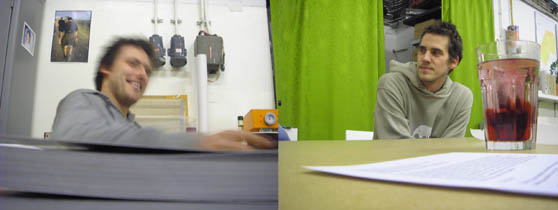 |
Lukáš Kordík: We were originally called Unit. After we moved, we discovered an advertisement for a "provider" with that name in the neighborhood. We came up with RAUM on the train from Košice while working on the Aupark competition. We thought this could be the official start with a new name. RAUM (it also contained TRAUM) may reference raumplan, space in general, but there's no need to seek any serious philosophy behind it. (The name came first, and then we added the philosophy...). So it would be easy "to pronounce." From the start, we didn’t want abbreviations of names.
 |
Roman Žitňanský: There is certainly no competition. We are friends. Everyone plays in their own sandbox, we don’t throw sticks under each other's feet. When help is needed, we are happy to assist.
L.K.: Well, it's not that harmonious either. We definitely exchange experiences and advise each other. But we can also tease each other quite decently. But there are certainly no joint brainstorming sessions.
-It is indeed a beautiful space, and it's actually in the city center. What is the rent like here?
R.Ž.: We share the rent based on how much space each of us uses; we pay about 15 thousand for our part. The owners change frequently; in the year and a half we've been here, it’s already been the fourth owner, and it certainly isn’t permanent. The space is representative, but we share it with 3 teams, and sometimes it can be quite a problem to hold a meeting within our own team. But it can't compare to how we were squeezed into 30m² with three people in our previous space. That was complete "hardcore." Then we wanted to rent an apartment, which was also impossible, since we wanted it officially so it could be deducted as an expense. Then this space became available.
 |
L.K.: If we were doing better, we wouldn’t have to work at all (laughs).
R.Ž.: We survive, but we don’t save anything. It’s hard to calculate precisely because sometimes there are dry spells when we scrape by and then it piles up again. We are constantly working on various projects, and many of them are still unpaid.
L.K.: The best would be if there were little work, good work, and well-paid work. So there would be time for it. We are still at the beginning and trying to put in the maximum. We are often running around and solving things. And that work is never paid. It translates into phone calls, into traveled kilometers, etc.
-You were classmates at FA STU. Did the idea of a joint studio come about in school? Under what circumstances did you decide to go "for it" together?
L.K.: No, it was a coincidence. I was initially only with Peťo. Later I started working with Oliver (VSA). Then Matúš (VSA) got involved, and then we split up. We kept adding someone else. The basis was to get together. I couldn't imagine a Slovak studio where I would want to work. Roman and I were together in France through the "Erasmus" program (where we basically did nothing). We've been together in this final lineup for three years. We got together right after school when we had to start paying social security, etc. Some of us already knew each other from high school. Everything in Bratislava is just interconnected.
However, certain changes have occurred. We are no longer four, but three. Marcel left for various reasons at the beginning of the year. I think he will end up as a member of parliament or mayor. Marcel left right after he succeeded in the local elections. He is now working for a construction company. He has a fresh family and needed bigger security. It's true that it has been quite stressful here lately.
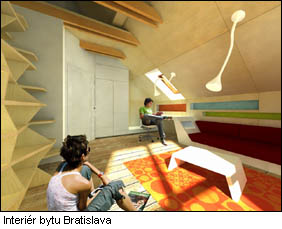 |
L.K.: We are like communists. After three years, we figured out what works and what doesn’t; everyone profiles themselves. Marcel left. Maybe someone else will replace him and push it somewhere else. We’ll see...
-Each of you has at least minimal experience in another studio (Fabrica, IKEA, Skoček, KFA, Fr). Did you bring various procedures from those studios and apply them in forming yours? They say that working somewhere is a fast track. You go through the "u.r.-ko," etc.
L.K.: We are advocates of "virgin purity."
R.Ž.: I worked for Ilja Skoček. He was a machine in this regard; he had his systems. But that can’t be fully adopted. Maybe at first we had some similar system, but we’ve moved on. And mainly, Ilja is an interior designer, so I did very little design work with him. Today, we assign those tasks to professionals. Personally, I admit that I still don’t know a lot about it.
-And who among you knows something about it?
L.K.: Marcel was that! He’s a machine. When he sat down to it, Cad just burned. Today I drew the drawing of plugs for the first time, and I don’t know how to finish it. We know who is best at what, and we try to divide it up.
R.Ž.: Marcel always did the "dirty work." Even with those offices, he had his women, of whom we had no idea. He communicated all that. Now at least we will be forced to tackle it ourselves.
 |
L.K.: We don’t deal with it; we dress however everyone likes. Recently, I’m so irritated that jeans restrict me too much.
R.Ž.: But many times they think of us as some kind of jerks.
L.K.: We’ve never worn suits.
R.Ž.: When we went to present in Košice, we were indeed better dressed, but not in suits.
-Young (not only) architects sometimes feel a sense of superiority from investors, professionals, or builders due to their age and inexperience. Do you think that the way of presenting also contributes to that?
R.Ž.: We have reached a stage where when someone wants something from us, it's due to work, not because of how we look. Rather, on the construction site, when masters see us, they tend to show that they know better than us.
L.K.: In Slovakia, everyone is an architect. Everyone has remodeled a cottage or worked on a flat and knows better how to do it...
-So do you recommend young, starting architects to gain experience in an established architectural firm, or are you advocates of "virgin purity"?
L.K.: Certainly, such an experience is positive, but it depends on which studio...
R.Ž.: But school can also ruin you.
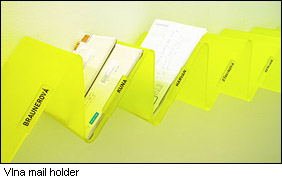 |
L.K.: The worst is doing work for family. For friends, even worse.
R.Ž.: There was a change with the Peugeot competition in Trnava with Števo Polakovič. Until then, we were basically doing everything. Števo then contacted us through Matúš Vallo for a competition on apartment buildings, which we won, but of course nothing came of it. Since then, we’ve started collaborating more intensively with Števo. When we had no work, we did some projects with him.
L.K.: Regarding those private matters: there's one line from Peťo. Those are the top managers of Slovak IT companies. They all want houses now. Interiors are for friends. During the SUSHI project, I met a classmate from high school who started telling me about SUSHI and cassette ceilings. We didn't give it large chances, and in the end, it was successfully realized. Someone always gets a break. We've only done a few competitions. The competition for Aupark led to a distaste for competing. We did a competition in the Czech Republic for a primary school in Úvaly. For Oracle, we arranged office spaces. From that, the "Vlna" design emerged, which was selected for a world design exhibition.
A house was made for Peťo's uncle, who then recommended us to someone else. VSA cannot understand how many houses we are currently working on (laughs). They are leading family houses, apartments, and moderately-sized apartment buildings. Recently, they’ve also ventured into urbanism.
 |
L.K.: It’s a larger topic, urbanism around Bratislava on 50 hectares. It arose from the investor's initiative who contacted us but had an interesting condition: he wanted to involve a foreign studio. Together with the investor, we traveled to the Netherlands, first to a studio where we didn't succeed. Then we reached out to John Bosch. We already knew John through the guys from VSA who had already collaborated with him on a project in Bratislava. He got into it quite well, initially somewhat awkwardly, but then we clicked on a human level, and I think the investor is ultimately satisfied too. Hopefully, the result will be as well. We just signed the contract. So we travel to the Netherlands about three times a month, and John comes here as often.
-The biggest problem for young architects is clients' distrust due to age and inexperience. It is well known that the combination of a starting studio with an experienced, authorized architect is a proven and often used way to realize their visions even without missing experience and references. How have you dealt with this issue?
L.K.: We’ve been working on some projects with Števo Polakovič and Roman Halmi for a while now, but none of those projects have yet materialized into reality. They are larger projects. If we hadn’t clicked on a human level, it probably wouldn’t have worked out. One family house is currently under construction, and the other is about to be prepared. Finally, a wooden structure, not bricks.
R.Ž.: Studies are made here, as well as "u.r.-ko" when needed. We assign "stavebko" to professionals, but we collaborate on it until the end.
L.K.: Currently, we are working with the mentioned John Bosch.
-How does the creative process work in your team? Do you have divided roles: design, engineering, communication, PR, economics, ... or does everyone do everything?
L.K.: Very dramatically. Everyone does everything. We don’t really focus much on PR.
R.Ž.: We have voracious sharks from VSA next door (laughs). They make fun of us that for us, PR is a crime. We don’t deal with it that much. If we know something is good, we’re happy to brag about it.
L.K.: For us, the biggest PR is a satisfied client (laughs).
-You create beautiful images, almost like Jehovah's Witnesses. One would say that two of you worked in advertising.
It all started with the Aupark, where we got so caught up that we included all those Košice "celebrities." But there came a moment when we said, why make such polished visualizations. SketchUp is enough. It takes a lot of time. And for the projects that were realized, the visualizations were made minimally.
-Graphic designer Ján Šicko is the author of your website. He is also a co-author of your last realization "SUSHI" in Bratislava, where his signature is quite present. How do you perceive interdisciplinarity in architectural practice? Do you expand your interest into new areas of creativity beyond the traditional sphere of architecture?
L.K.: He invented the principle - design manual. It should definitely be like that: when I do graphics, I do graphics; when I do architecture, I do architecture. In the beginning, Janči was supposed to do only the web and prints. Only during the studies did we invite him for closer collaboration. Paradoxically, we kept saying throughout that we shouldn't end up with some grass motifs. Our friends put those everywhere (laughs). Maybe we paraphrased them graphically, but it completely stemmed from the designer's concept; in this regard, we are pure. It’s great to collaborate like that. If it could also include music, I would collaborate with a musician as well. I think that collaboration between people just advances things and can help!
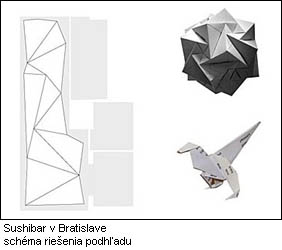 |
L.K.: It’s true that we hardly go there. The staff bothers me. The waitress who was in a reality show will kick you out if you just want to sit down. Our contribution is about 30% of the success; another thing is the kitchen and the staff. We can make the whole interior out of gold, and no one will come.
R.Ž.: The architect has some influence, but it’s perhaps a tenth of all influences.
L.K.: The investor wanted luxury; we tried to make it as raw as possible. So far, they can't come to terms with the cement on the floor. We hope that the wood will look worn over time. It should be recognized that so far this has been the only client who said: "You are architects, you know." They will probably still add some partitions to those glass walls to close it a bit.
R.Ž.: Maybe somewhere in Austria or the Czech Republic, one wouldn’t care if it’s too bright or what. Such types of establishments are normal there. The question is whether to adapt to the non-demanding Slovak consumer. We didn’t want that. In Slovakia, people are still not accustomed to such things. They are afraid of it, have concerns.
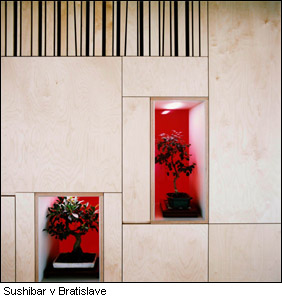 |
R.Ž.: We worked with a skilled carpenter. Since we didn't know many things, we consulted and sketched them together.
L.K.: We clearly stated what we wanted. This carpenter was sufficiently knowledgable to advise us on what to do.
-How much emphasis do you place on presentation? Models, visualizations …
R.Ž.: From the beginning, we have our own quite high standard in graphic presentation. Many times we linger with it; we spend half the time inventing it and the other half adjusting it, etc. We dedicate a lot of time to it and have gotten used to it. It has a good response.
L.K.: After two years, I fulfilled my dream and bought a cutter for polystyrene, but so far it’s unused...
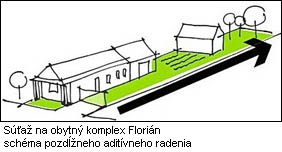 |
R.Ž.: We try to show how we were thinking so that the client can see how we arrived at it. Not everyone can understand just from pictures.
L.K.: It would be best if they were real sketches. The diagrams are then made ex-post.
-Aren't you tempted to transition from diagrams to diagrams? To parametrically designed solutions? A diagram, if one believes in it, can significantly facilitate decision-making.
R.Ž.: We deal with concepts based on input information from the land or from the client. We don’t give ourselves higher mathematics. We work with the land, views, sun...
L.K.: It helps me; I change things up until the last moment. ...Diagrams emerge during that process. At Lazarecká with the apartment building, there was a concept - several theses. It was said what would be great, what the principle is, what should work for that apartment building. Then there are compromises that come from, for example, construction, minimization, communication. With Dunajská, we burned ourselves, so we said these are the 5 main points, and let’s proceed according to that.
R.Ž.: We do it more or less evolutionarily, but we can say that from the beginning, we have some idea, and we hope that’s how it will turn out. We sketch it out.
L.K.: It’s about the principle. Whether you want a patio or loggias. An introverted house and at the same time extroverted...
-To what extent are you willing to experiment in architecture? Do you prefer experimentation in space, in materials, or in interdisciplinarity?
R.Ž.: We don't shy away from it, but our position may not be stable enough yet for us to defend our experimentation.
L.K.: Although with SUSHI, we succeeded. You just need to not be afraid and want to go for it, to try it. Experiments often cost a lot of money and time. There was a moment here where people who liked it met and went for it. Until the last moment, we didn’t know how to do, for example, the ceiling.
R.Ž.: We may not try to experiment that much with materials, but rather with the creation of the concept itself.
L.K.: It’s about estimating the client, to what extent is there space for it. This can be done precisely when you are just building your name.
R.Ž.: We say to ourselves that if we don’t experiment now, then when?
L.K.: In the Netherlands, we were fascinated by the fact that they are the kings of the atypical. There, a custom-made atypical solution is cheaper than a prefab. I would enjoy doing such tests and then using them. Unfortunately, here, the kings are bramac, plaster, and system facades.
-Are you willing to tell a client no?
R.Ž.: I have a problem with that.
L.K.: I am radical in this regard. There were projects we withdrew from, and some we didn't even start.
 |
L.K.: I can’t really assess if it’s improving. However, Števo Polakovič says that what it was like 10 years ago is incomparable. It’s definitely changing. Architecture has become popular; people read magazines, they apply to architecture. It's "in," and people try to be "in."
-What positive things has the activity of SAS brought you as a young studio? The Chamber? And other happenings in the Slovak architectural scene?
L.K.: The Chamber is completely unnecessary. We don’t know what it does. In architecture, it's common for someone to do something for a normal price, put a normal percentage on it, and find someone else to do it for half the price. As for competitions, it probably can’t get more of a faux pas than that. Why do they guarantee competitions? The result is always such that the winner does not do it anyway. I don’t understand what the architects’ chamber is good for in this form.
R.Ž.: As for the Association, we are not members.
L.K.: We are currently avoiding authorization. It’s positive that the Association publishes the magazine Projekt.
-In almost every European country, various alternative platforms (blogs, websites, centers...) exist to promote contemporary architecture and stimulate discourse. Slovakia somehow lags in this. Would you welcome something similar in the domestic architectural scene?
L.K.: There is a "Clubovka" here. Táňa Kollárová, who organizes it, is absolutely great and passionate. It would be nice if there were a possibility to present young studios there as well. For instance, there will be a projection about contemporary architectural creation in Prešov; Táňa arranged it with the city (Architecture Festival). The magazines still have the same thing. Maybe the internet would be a good medium. It’s great to see what everyone is doing and exchange opinions. Everyone would welcome it, but there needs to be someone to organize it. That’s the problem.
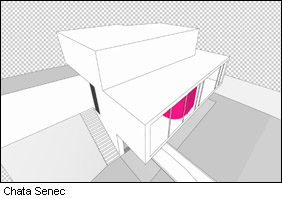 |
L.K.: I recently saw a competition for the Tatras, and it was like a competition from Austria. A kind of Austrian student one. It’s true that Austria has the same climatic conditions as we do. What is built, for instance, in Portugal is unrealistic for us. But if we look at what is built in Estonia, we see that they are already "slanted." Europe is "slanted." We don’t try to skew just for the sake of it. Recently, we’ve often used archetypes. If it can save some cubic meters of unnecessary space, then it’s great to skew. We like sloped roofs. Sloping is "in." Whoever doesn't skew is not an architect (laughs). But flat walls are good too (laughs).
-Thank you for the interview.
The English translation is powered by AI tool. Switch to Czech to view the original text source.
1 comment
add comment
Subject
Author
Date
(smiech)
03.04.08 11:06
show all comments










